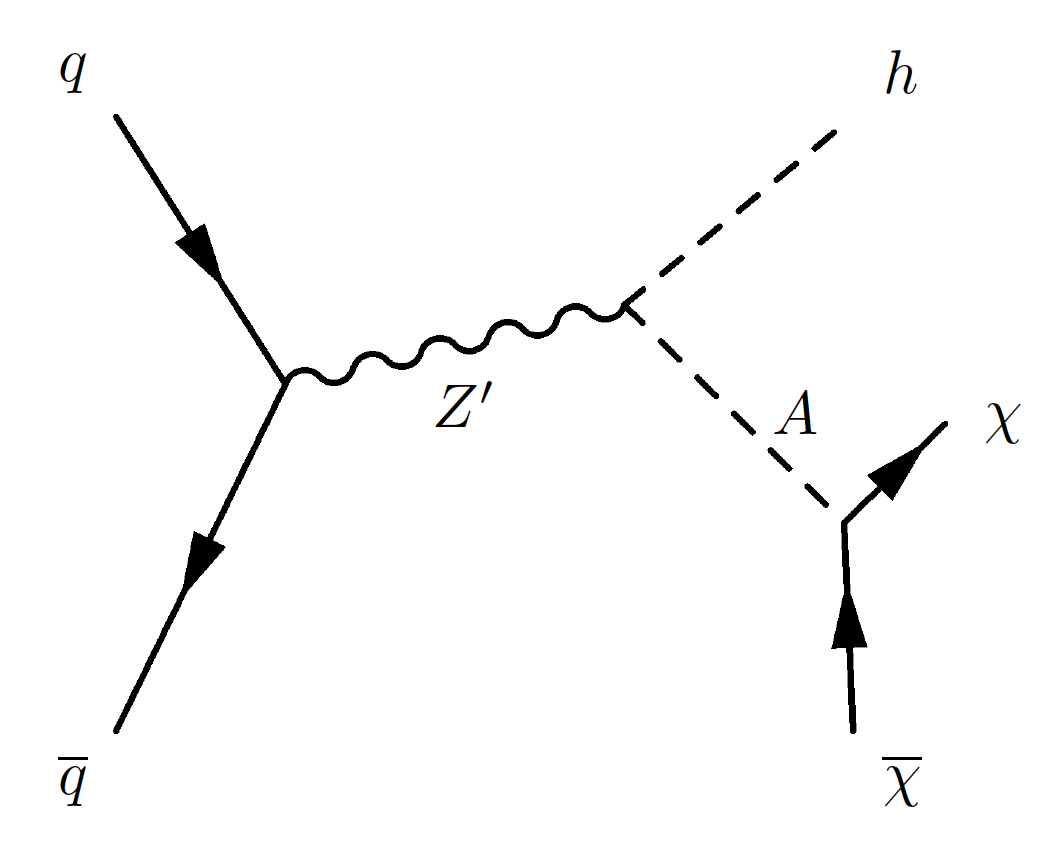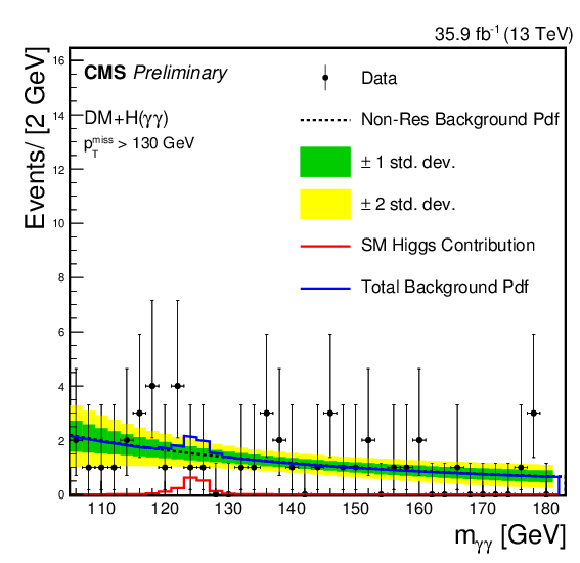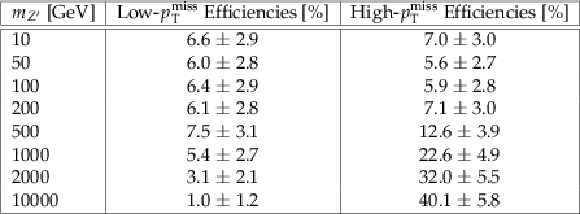

Compact Muon Solenoid
LHC, CERN
| CMS-PAS-EXO-16-054 | ||
| Search for Dark Matter produced in association with a Higgs boson decaying to two photons | ||
| CMS Collaboration | ||
| May 2017 | ||
| Abstract: A search for the associated production of dark matter with a Higgs boson which decays into two photons is presented. The search uses data from proton-proton collisions at a center-of-mass energy of 13 TeV, collected with the CMS detector at the LHC in 2016, corresponding to an integrated luminosity of 35.9 fb$^{-1}$. Results are interpreted in the context of two dark matter models: a two-Higgs-doublet-Z' model where the Z' decays to a pseudoscalar and a standard model-like Higgs Boson and a baryonic Z' simplified model. The search is performed categorizing the events based on the amount of missing transverse momentum in order to also be sensitive to hypothetical signals with small amounts of missing transverse momentum. After the final selection, no significant evidence for dark matter particle production has been observed. Two-Higgs-doublet-Z' signals with a pseudoscalar mass of 300 GeV are excluded at 95% of CL for Z' masses below 900 GeV. Baryonic Z' models with a dark matter mass of 1 GeV are excluded at 95% of CL for Z' masses below 800 GeV. | ||
| Links: CDS record (PDF) ; inSPIRE record ; CADI line (restricted) ; | ||
| Figures | |

png pdf |
Figure 1:
Feynman diagrams for the benchmark DM signal models: baryonic Z' (left) and 2HDM (right). |

png |
Figure 1-a:
Feynman diagram for the benchmark DM signal baryonic Z' model. |

png |
Figure 1-b:
Feynman diagram for the benchmark DM signal 2HDM model. |

png pdf |
Figure 2:
Distribution of the missing transverse momentum of the events passing all other selection criteria. The cross sections of the signals are set to 1 pb. The total MC background is normalized to the integral of the data. Only the MC statistical uncertainties on the total background are shown in the hatched bands. The data-to-simulation ratio is shown in the lower panel. |

png pdf |
Figure 3:
The ${m_{\gamma \gamma }}$ distribution after all selection is applied in the low-$ {p_{\mathrm {T}}^{\mathrm {miss}}}$ (left) and high-$ {p_{\mathrm {T}}^{\mathrm {miss}}}$ (right) categories. The cross section of the signals are set to 1 pb. The total MC background is normalized to the integral of the data. Only the MC statistical uncertainties on the total background are shown in the hatched bands. The data-to-simulation ratio is shown in the lower panel. |

png pdf |
Figure 3-a:
The ${m_{\gamma \gamma }}$ distribution after all selection is applied in the low-$ {p_{\mathrm {T}}^{\mathrm {miss}}}$ category. The cross section of the signals are set to 1 pb. The total MC background is normalized to the integral of the data. Only the MC statistical uncertainties on the total background are shown in the hatched bands. The data-to-simulation ratio is shown in the lower panel. |

png pdf |
Figure 3-b:
The ${m_{\gamma \gamma }}$ distribution after all selection is applied in the high-$ {p_{\mathrm {T}}^{\mathrm {miss}}}$ category. The cross section of the signals are set to 1 pb. The total MC background is normalized to the integral of the data. Only the MC statistical uncertainties on the total background are shown in the hatched bands. The data-to-simulation ratio is shown in the lower panel. |

png pdf |
Figure 4:
The power law (dashed black) fit to the data and SM h ${\rightarrow \gamma \gamma }$ contribution (solid red) for low-$ {p_{\mathrm {T}}^{\mathrm {miss}}}$ (left) and high-$ {p_{\mathrm {T}}^{\mathrm {miss}}}$ (right) categories. Shown in solid blue is the sum of the non-resonant and resonant shapes used to estimate the total background in this analysis. |

png pdf |
Figure 4-a:
The power law (dashed black) fit to the data and SM h ${\rightarrow \gamma \gamma }$ contribution (solid red) for the low-$ {p_{\mathrm {T}}^{\mathrm {miss}}}$ category. Shown in solid blue is the sum of the non-resonant and resonant shapes used to estimate the total background in this analysis. |

png pdf |
Figure 4-b:
The power law (dashed black) fit to the data and SM h ${\rightarrow \gamma \gamma }$ contribution (solid red) for the high-$ {p_{\mathrm {T}}^{\mathrm {miss}}}$ category. Shown in solid blue is the sum of the non-resonant and resonant shapes used to estimate the total background in this analysis. |

png pdf |
Figure 5:
The upper limits on cross section for the 2HDM scenario as a function of $m_{{\mathrm{ Z }'} }$ for $m_{A} = $ 300 GeV. The theoretical cross section (blue) is calculated assuming $g_{{\mathrm{ Z }' } } = $ 0.8. |

png pdf |
Figure 6:
The observed (expected) 95% CL limits on the signal strength ($ \sigma _{95\% CL}/\sigma _{th} $) for all 2HDM mass points shown in a grid of $m_{A}$ and $m_{Z'}$. The theoretical cross section for each point is calculated assuming $g_{{\mathrm{ Z }pr } } = $ 0.8. |

png pdf |
Figure 7:
The upper limits on cross section for the baryonic Z' scenario as a function of $m_{{\mathrm{ Z }' } }$ for $m_{\chi } = $ 1 GeV. The theoretical cross section (blue) is calculated assuming $g_{q} = $ 0.25 and $sin(\theta )= $ 0.3. |
| Tables | |

png pdf |
Table 1:
Maximum allowed value of each variable used in barrel and endcap photon identification [26]. The ${p_{\mathrm {T}}}$ used in these formulas is expressed in GeV. |

png pdf |
Table 2:
Optimized kinematic requirements for the low- and high-$ {p_{\mathrm {T}}^{\mathrm {miss}}}$ categories. |

png pdf |
Table 3:
Expected background yields and observed amount of data in the ${m_{\gamma \gamma }}$ range of 122 to 128 GeV for low- and high-$ {p_{\mathrm {T}}^{\mathrm {miss}}}$ categories. The non-resonant background includes QCD, $\gamma \gamma $, $\gamma $+jet, and EWK backgrounds and is estimated from the fit to data. The irreducible background from the SM Higgs boson associated production is presented separated from the the SM Higgs boson production modes. For the resonant background contributions both the statistical and the systematic uncertainties are listed. As detailed in Sec. 6.1 we do not include any systematic uncertainty associated to the non-resonant background. |

png pdf |
Table 4:
Efficiency times acceptance and statistical uncertainty for the 2HDM in both the low- and high-$ {p_{\mathrm {T}}^{\mathrm {miss}}}$ categories. Samples that have negligible efficiencies in the low-$ {p_{\mathrm {T}}^{\mathrm {miss}}}$ category are shown with a dash (/). |

png pdf |
Table 5:
Efficiency times acceptance and statistical uncertainty for the Baryonic Z' model in both the low- and high-$ {p_{\mathrm {T}}^{\mathrm {miss}}}$ categories. Efficiencies are calculated for several Z' mass points for a fixed $m_{\chi } = $ 1 GeV. |
| Summary |
|
A search for dark matter produced in association with a Higgs boson is presented. This analysis examines the case where the Higgs boson decays to two photons. The analysis is based on 35.9 fb$^{-1}$ of pp collisions collected by the CMS experiment in 2016 at $\sqrt{s} =$ 13 TeV. The results of the search are interpreted in terms of 2HDM and baryonic Z' simplified models of dark matter production. After passing trigger requirements, events are selected if they contain two photon candidates passing kinematic requirements on the $p_{\mathrm{T}}/m_{\gamma\gamma}$ of the two photons, $ E_{\mathrm{T}}^{\text{miss}} $ and $p_{\mathrm{T}\gamma\gamma}$ obtained with an optimization study on the benchmark models. The selection optimization has been performed in both low- and high-$ E_{\mathrm{T}}^{\text{miss}} $ categories. A jet veto is applied to reduce the QCD background. Topological requirements avoid events with highly energetic jets collinear with the $ E_{\mathrm{T}}^{\text{miss}} $ for which the $ E_{\mathrm{T}}^{\text{miss}} $ could simply arise from a misreconstruction of the jet itself. Data driven techniques are applied to estimate the non-resonant background contributions. Limits on the signal cross section are calculated. 2HDM signals with $m_{A} = $ 300 GeV are excluded for Z' masses below 900 GeV. Baryonic Z' models are excluded for Z' masses below 800 GeV for a dark matter mass of 1 GeV. Results are mostly driven by the high-$ E_{\mathrm{T}}^{\text{miss}} $ category for the analyzed signal models. |
| References | ||||
| 1 | CMS Collaboration | Observation of a new boson at a mass of 125 GeV with the CMS experiment at the LHC | PLB 716 (2012) 30 | |
| 2 | ATLAS Collaboration | Observation of a new particle in the search for the Standard Model Higgs boson with the ATLAS detector at the LHC | PLB 716 (2012) 1 | |
| 3 | ATLAS Collaboration | Search for Dark Matter in Events with Missing Transverse Momentum and a Higgs Boson Decaying to Two Photons in pp Collisions at $ \sqrt{s}= $ 8 TeV with the ATLAS Detector | PRL 115 (2015) 131801 | |
| 4 | CMS Collaboration | Search for Dark Matter Produced in Association with a Higgs Boson Decaying to Two Photons | CMS-PAS-EXO-16-011 | CMS-PAS-EXO-16-011 |
| 5 | ATLAS Collaboration | Search for dark matter in association with a Higgs boson decaying to $ b $-quarks in $ pp $ collisions at $ \sqrt{s}= $ 13 TeV TeV with the ATLAS detector | PLB765 (2017) 11--31 | 1609.04572 |
| 6 | ATLAS Collaboration | Search for new phenomena in events with missing transverse momentum and a Higgs boson decaying into two photons at $ \sqrt{s} = $ 13 TeV with the ATLAS detector | ATLAS-CONF-2017-024, CERN, Geneva, Apr | |
| 7 | CMS Collaboration | Search for associated production of dark matter with a Higgs boson decaying to $ b\bar{b} $ or $ \gamma\gamma $ at $ \sqrt{s} = $ 13 TeV | CMS-EXO-16-012 1703.05236 |
|
| 8 | L. Carpenter et al. | Mono-Higgs-boson: A new collider probe of dark matter | PRD89 (2014), no. 7, 075017 | 1312.2592 |
| 9 | A. Berlin, T. Lin, and L. Wang | Mono-Higgs detection of dark matter at the LHC | JHEP 2014 (2014) 1 | |
| 10 | D. Abercrombie et al. | Dark Matter Benchmark Models for Early LHC Run-2 Searches: Report of the ATLAS/CMS Dark Matter Forum | 1507.00966 | |
| 11 | CMS collaboration | The CMS experiment at the CERN LHC | JINST 3 (2008) S08004 | |
| 12 | J. Alwall et al. | The automated computation of tree-level and next-to-leading order differential cross sections, and their matching to parton shower simulations | JHEP 2014 (2014) 1 | |
| 13 | T. Gleisberg et al. | Event generation with SHERPA 1.1 | JHEP 2 (2009) 007 | |
| 14 | T. Sj\"ostrand, S. Mrenna, and P. Skands | An Introduction to PYTHIA 8.2 | CPC 191 (2015) 159 | |
| 15 | S. Agostinelli et al. | Geant4 --- a simulation toolkit | NIM A 506 (2003) 250 | |
| 16 | CMS Collaboration | Commissioning of the particle-flow event reconstruction with the first LHC collisions recorded in the CMS detector | CDS | |
| 17 | CMS Collaboration | Commissioning of the particle-flow event reconstruction with the first LHC collisions recorded in the CMS detector | CDS | |
| 18 | CMS Collaboration | Description and performance of track and primary-vertex reconstruction with the CMS tracker | JINST 9 (2014), no. 10, P10009 | CMS-TRK-11-001 1405.6569 |
| 19 | CMS Collaboration | CMS Physics Technical Design Report, Volume II: Physics Performance | JPG34 (2007) 995 | |
| 20 | CMS Collaboration | Performance of photon reconstruction and identification with the CMS detector in proton-proton collisions at $ \sqrt{s} = $ 8 TeV | JINST 10 (2015) P08010 | |
| 21 | CMS Collaboration | Particle-Flow Event Reconstruction in CMS and Performance for Jets, Taus, and MET | CDS | |
| 22 | M. Cacciari, G. P. Salam, and G. Soyez | The anti-$ k_t $ jet clustering algorithm | JHEP 04 (2008) 063 | 0802.1189 |
| 23 | CMS Collaboration | Jet energy scale and resolution in the CMS experiment in pp collisions at 8 TeV | CMS-JME-13-004 1607.03663 |
|
| 24 | CMS Collaboration | Performance of the CMS missing transverse energy reconstruction in pp data at $ \sqrt{s}= $ 8 TeV | JINST 10 (2015) P02006 | |
| 25 | M. Cacciari and G. P. Salam | Pileup subtraction using jet areas | PLB 659 (2008) 119 | |
| 26 | CMS Collaboration | Performance of Photon Reconstruction and Identification with the CMS Detector in Proton-Proton Collisions at $ \sqrt{s}= $ 8 TeV | JINST 10 (2015), no. 08, P08010 | CMS-EGM-14-001 1502.02702 |
| 27 | G. Punzi | Sensitivity of searches for new signals and its optimization | eConf C030908 (2003) MODT002 | physics/0308063 |
| 28 | CMS Collaboration | Updated measurements of Higgs boson production in the diphoton decay channel at $ \sqrt{s}= $ 13 TeV TeV in pp collisions at CMS | CMS-PAS-HIG-16-020 | CMS-PAS-HIG-16-020 |
| 29 | CMS Collaboration | Search for dijet resonances in proton-proton collisions at sqrt(s) = 13 TeV and constraints on dark matter and other models | PLB (2016) | CMS-EXO-16-032 1611.03568 |
| 30 | CMS Collaboration | Search for resonant production of high-mass photon pairs in proton-proton collisions at $ \sqrt{s}= $ 8 and 13 TeV | PRL 117 (2016), no. 5, 051802 | CMS-EXO-16-018 1606.04093 |
| 31 | LHC Higgs Cross Section Working Group Collaboration | Handboook of LHC Higgs Cross Sections: 4. Deciphering the Nature of the Higgs Sector | 1610.07922 | |
| 32 | J. Butterworth et al. | PDF4LHC recommendations for LHC Run II | JPG43 (2016) 023001 | 1510.03865 |
| 33 | CMS Collaboration | Measurement of differential fiducial cross sections for Higgs boson production in the diphoton decay channel in pp collisions at $ \sqrt{s}= $ 13 TeV | CMS-PAS-HIG-17-015 | CMS-PAS-HIG-17-015 |
| 34 | CMS Collaboration Collaboration | CMS Luminosity Measurements for the 2016 Data Taking Period | CMS-PAS-LUM-17-001 | |

|
Compact Muon Solenoid LHC, CERN |

|

|

|

|

|

|